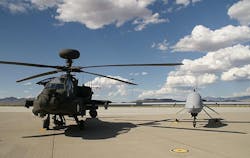DARPA asks industry to improve machine autonomy for safety-critical aircraft applications
Officials of the U.S. Defense Advanced Research Projects Agency (DARPA) in Arlington, Va., issued a broad agency announcement earlier this month (HR001117S0045) for the Assured Autonomy project to assure that systems will operate safely and perform as expected, which will promote trust in machine autonomy and speed its adoption.
The goal of the Assured Autonomy program is to develop rigorous design and analysis technologies to guarantee safety of autonomous machines that are able to learn on their own, based on experience.
This project will center on military autonomous vehicles. It will produce a set of publicly available software tools for use in commercial and defense sectors. DARPA seeks innovative techniques that render the learning algorithms inherently safe by incorporating safety constraints in the learning process, while meeting learning objectives.
Autonomous systems increasingly are critical to the military, and researchers have made tremendous advances in the last decade -- particularly for unmanned vehicles that operate in the air, on the ground, and in the ocean.
Enabling these advances in machine autonomy have been innovations in sensor and actuator technologies; computing technologies; control theory; design methods and tools; and modeling and simulation technologies.
In spite of these advances, however, adoption of such systems in safety-critical DOD applications remains challenging and controversial. Designing in reliability to ensure trust is key to widespread use of machine autonomy.
The Assured Autonomy program has four technology areas (TAs): design for assurance; assurance monitoring and control; dynamic assurance; and integration and an experimentation platform. Proposers may address any of the four TAs.
Design for assurance involves a learning-enabled, cyber physical system (LE-CPS); assurance monitoring and control involves breakthroughs in operation-time techniques for assured and safe operation of LE-CPS for assurance monitoring and control; dynamic assurance involves new approaches in dynamic assurance that integrates design time assurance with operation time assurance; and the experimentation platform will provide challenge problems for evaluation and demonstration of the assurance technologies.
Related: Lockheed Martin and partners to develop technology for autonomous unmanned aircraft
The program has three phases: an 18-month first phase for initial research and tool development; a 15-month second phase to focus on technology enhancement; and a 15-month third phase for technology maturation and demonstration on experimentation platforms.
Goals of the program are to increase scalability of design-time assurance; reduce overhead of operation-time assurance; scale up dynamic assurance; and reduce trials to assurance. DARPA officials say they expect to make several contract awards for this program.
Companies interested should submit abstracts to the DARPA BAA Website no later than 6 Sept. 2017 at https://baa.darpa.mil. Upload proposals no later than 19 Oct. 2017 at https://baa.darpa.mil.
More information is online at https://www.fbo.gov/spg/ODA/DARPA/CMO/HR001117S0045/listing.html.
Learn more: search the Aerospace & Defense Buyer's Guide for companies, new products, press releases, and videos
